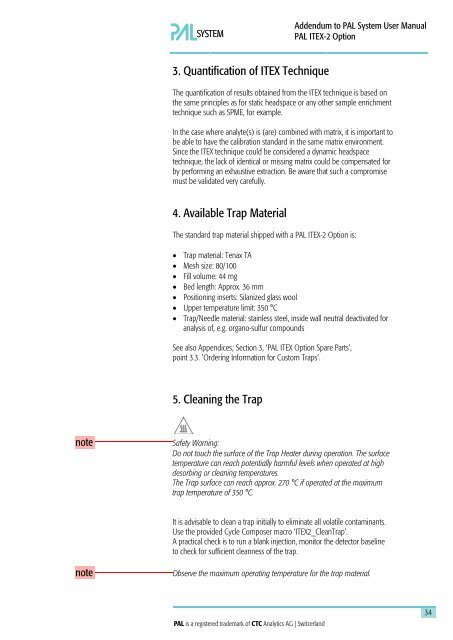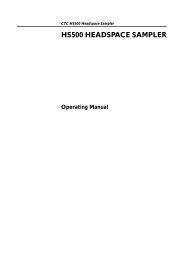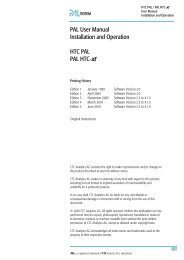Addendum to PAL User Manual Installation and ... - PAL System
Addendum to PAL User Manual Installation and ... - PAL System
Addendum to PAL User Manual Installation and ... - PAL System
Create successful ePaper yourself
Turn your PDF publications into a flip-book with our unique Google optimized e-Paper software.
note<br />
note<br />
3. Quantification of ITEX Technique<br />
<strong>Addendum</strong> <strong>to</strong> <strong>PAL</strong> <strong>System</strong> <strong>User</strong> <strong>Manual</strong><br />
<strong>PAL</strong> ITEX-2 Option<br />
The quantification of results obtained from the ITEX technique is based on<br />
the same principles as for static headspace or any other sample enrichment<br />
technique such as SPME, for example.<br />
In the case where analyte(s) is (are) combined with matrix, it is important <strong>to</strong><br />
be able <strong>to</strong> have the calibration st<strong>and</strong>ard in the same matrix environment.<br />
Since the ITEX technique could be considered a dynamic headspace<br />
technique, the lack of identical or missing matrix could be compensated for<br />
by performing an exhaustive extraction. Be aware that such a compromise<br />
must be validated very carefully.<br />
4. Available Trap Material<br />
The st<strong>and</strong>ard trap material shipped with a <strong>PAL</strong> ITEX-2 Option is:<br />
• Trap material: Tenax TA<br />
• Mesh size: 80/100<br />
• Fill volume: 44 mg<br />
• Bed length: Approx. 36 mm<br />
• Positioning inserts: Silanized glass wool<br />
• Upper temperature limit: 350 °C<br />
• Trap/Needle material: stainless steel, inside wall neutral deactivated for<br />
analysis of, e.g. organo-sulfur compounds<br />
See also Appendices; Section 3, ‘<strong>PAL</strong> ITEX Option Spare Parts’,<br />
point 3.3. ’Ordering Information for Cus<strong>to</strong>m Traps’.<br />
5. Cleaning the Trap<br />
Safety Warning:<br />
Do not <strong>to</strong>uch the surface of the Trap Heater during operation. The surface<br />
temperature can reach potentially harmful levels when operated at high<br />
desorbing or cleaning temperatures.<br />
The Trap surface can reach approx. 270 °C if operated at the maximum<br />
trap temperature of 350 °C.<br />
It is advisable <strong>to</strong> clean a trap initially <strong>to</strong> eliminate all volatile contaminants.<br />
Use the provided Cycle Composer macro ‘ITEX2_CleanTrap’.<br />
A practical check is <strong>to</strong> run a blank injection, moni<strong>to</strong>r the detec<strong>to</strong>r baseline<br />
<strong>to</strong> check for sufficient cleanness of the trap.<br />
Observe the maximum operating temperature for the trap material.<br />
34




